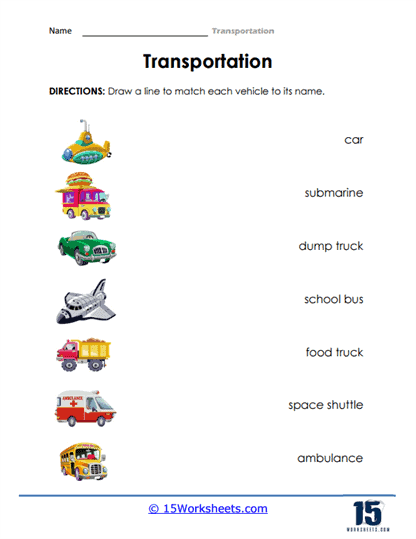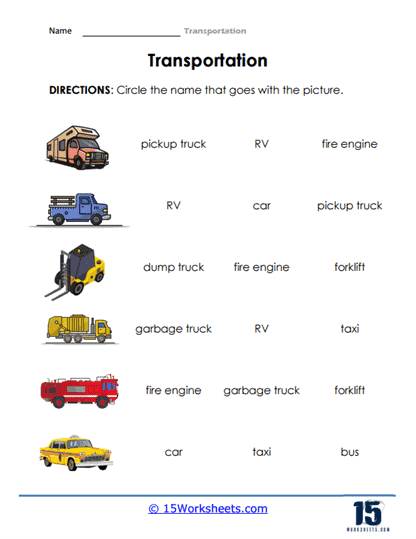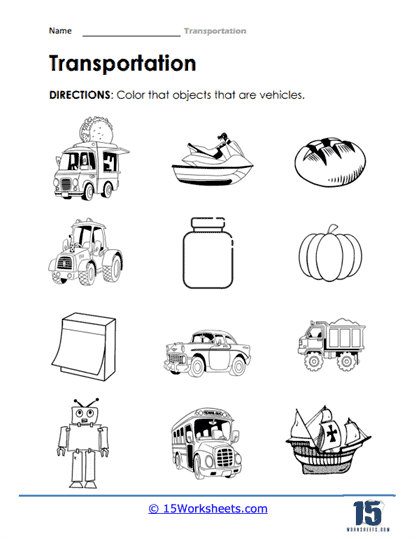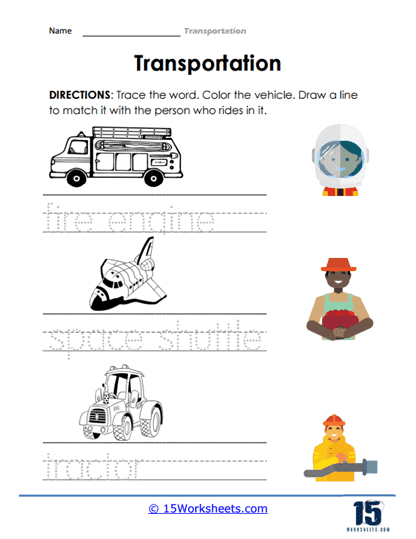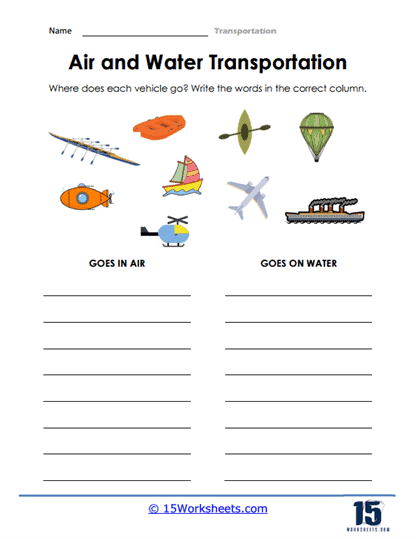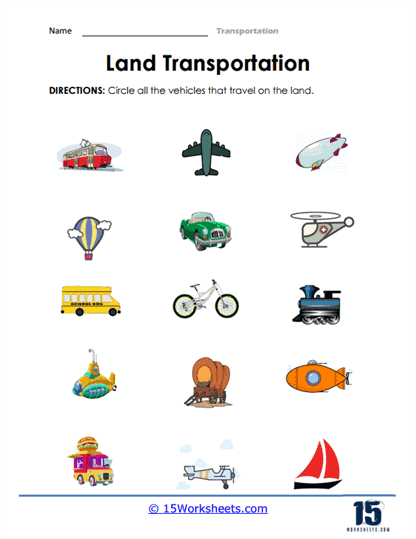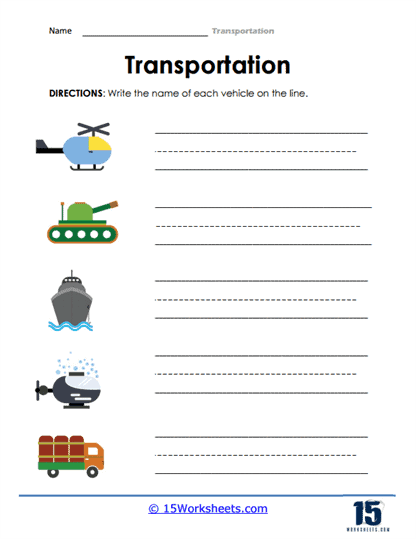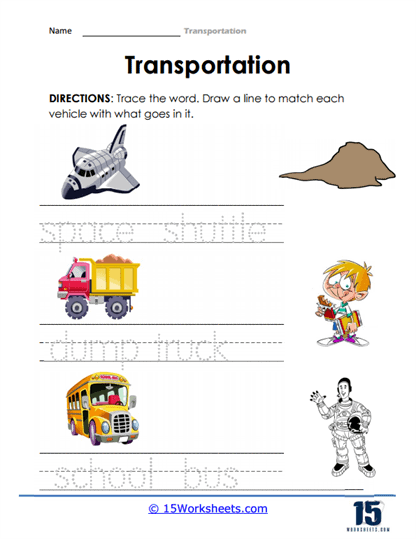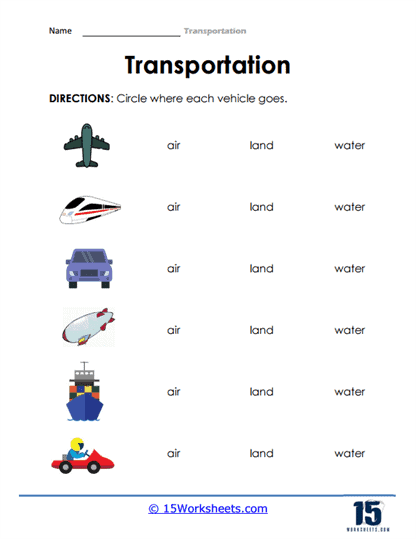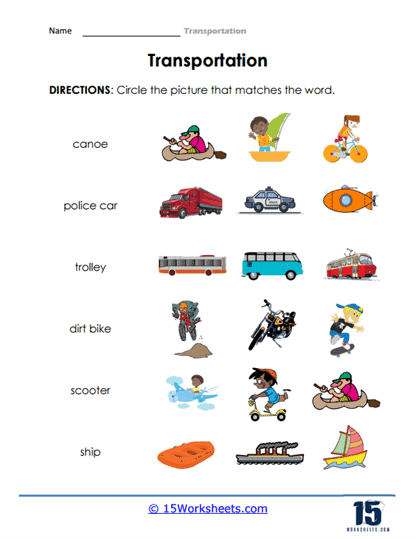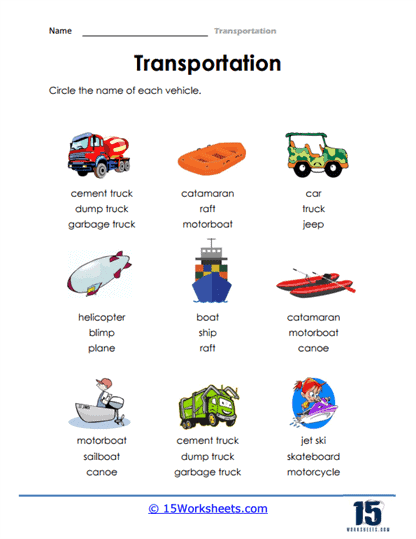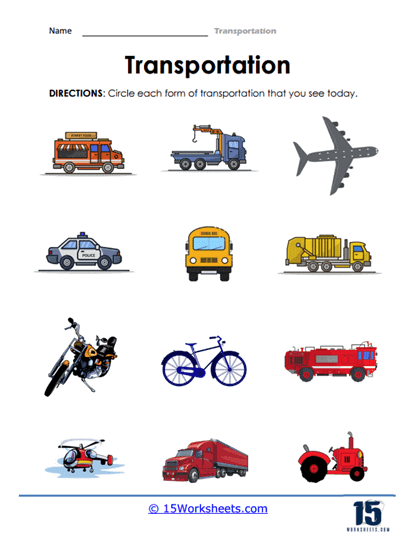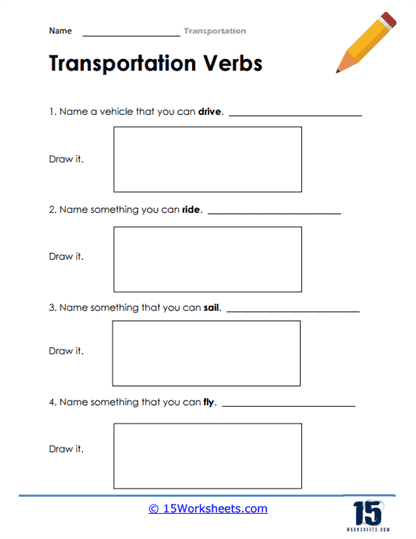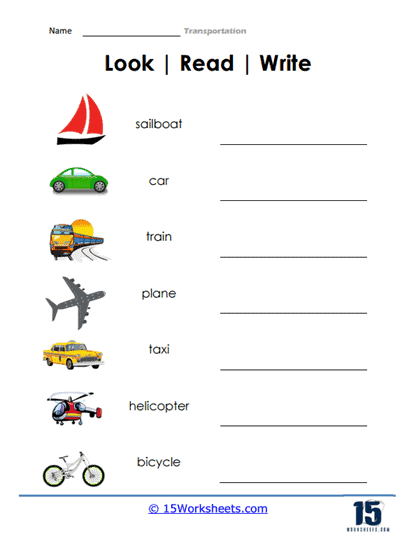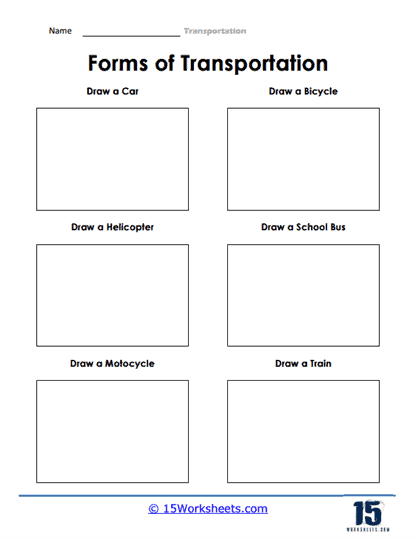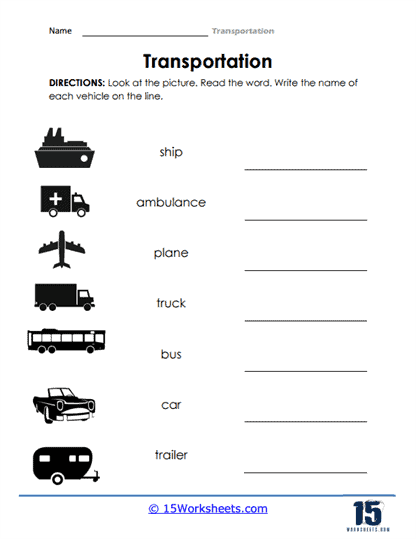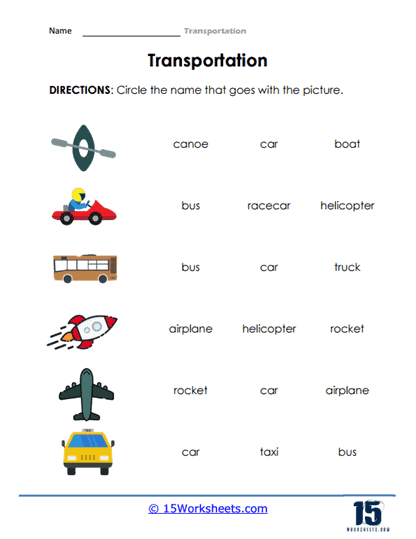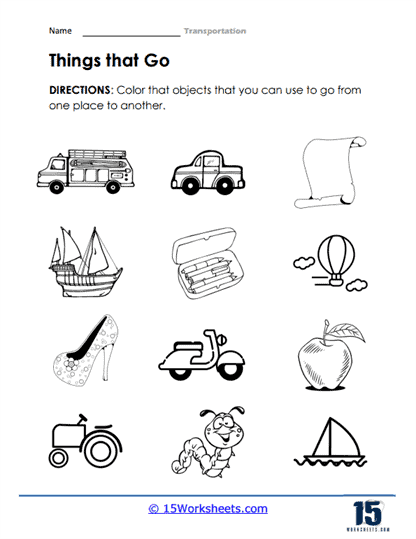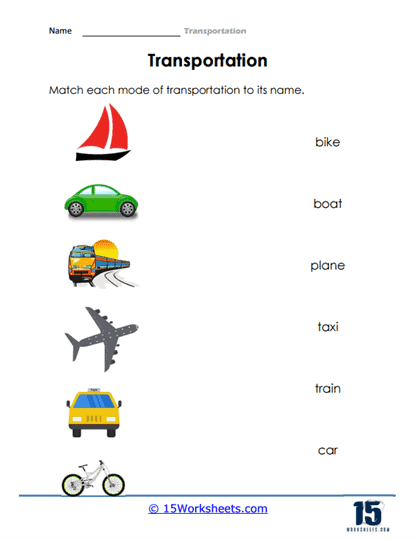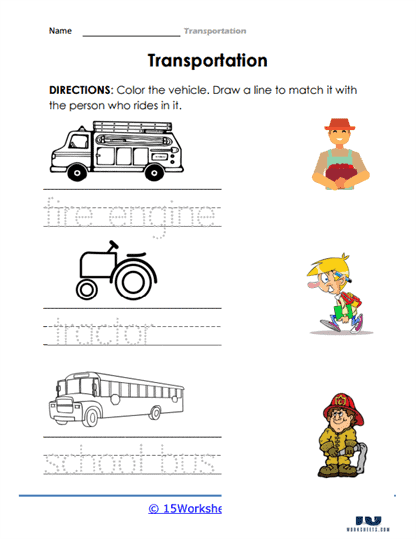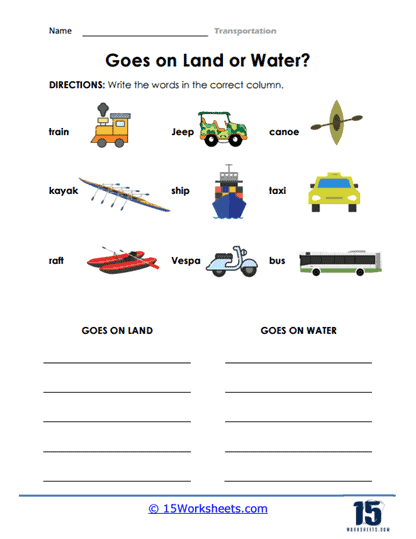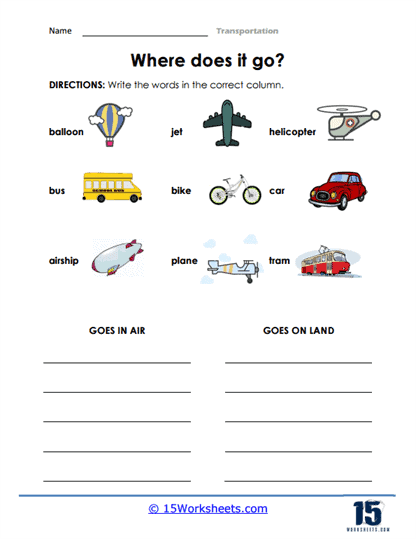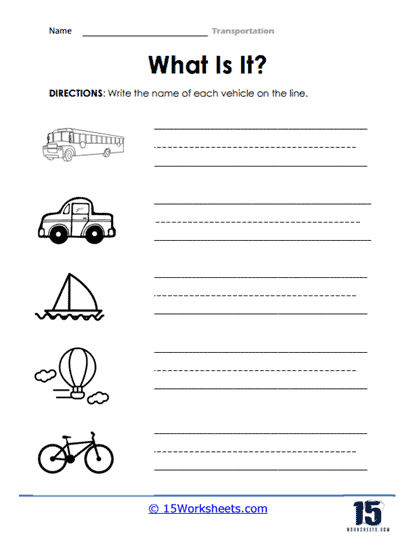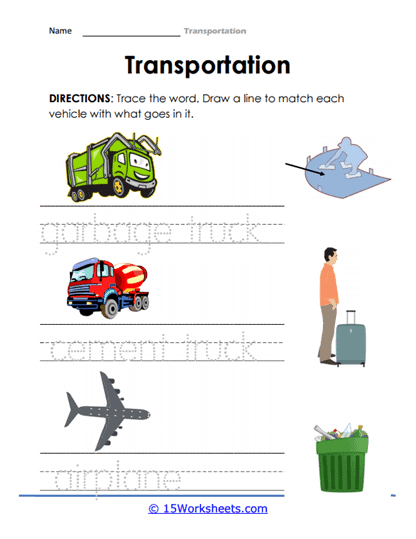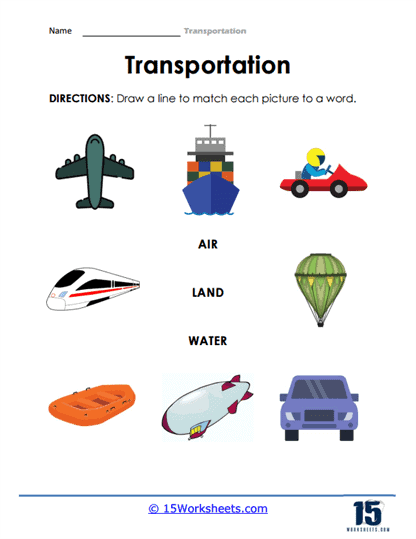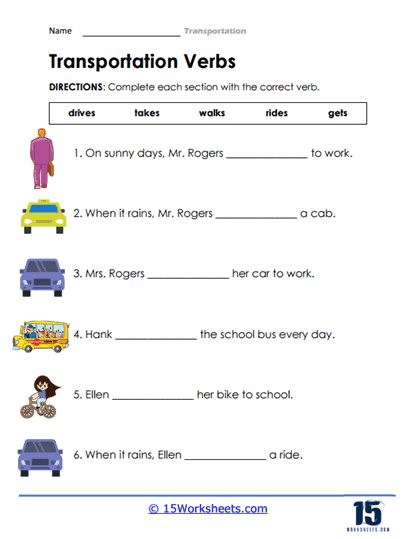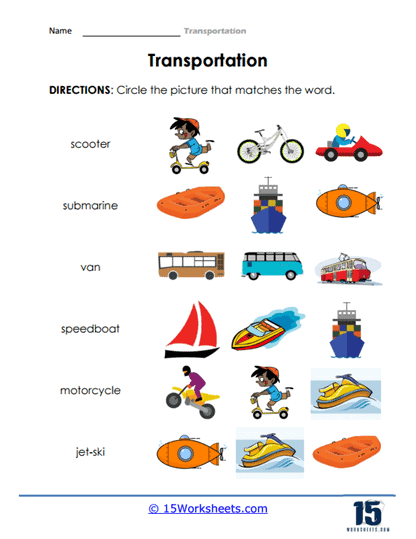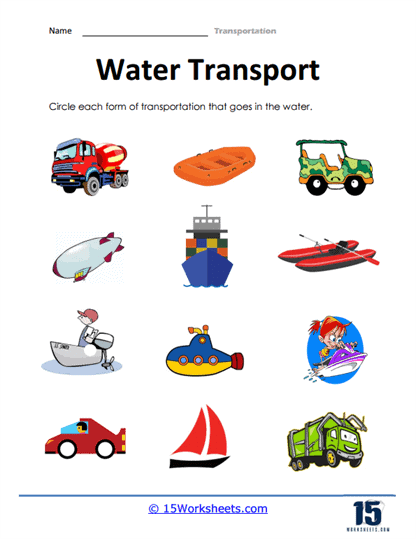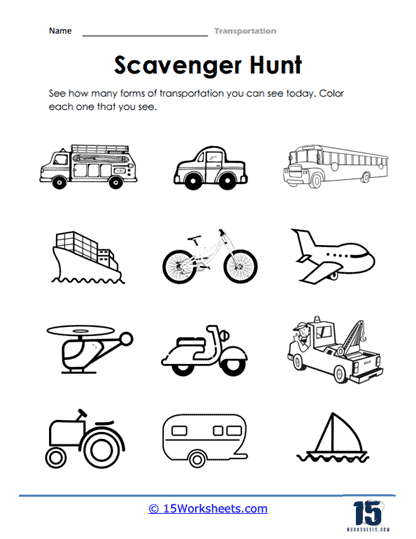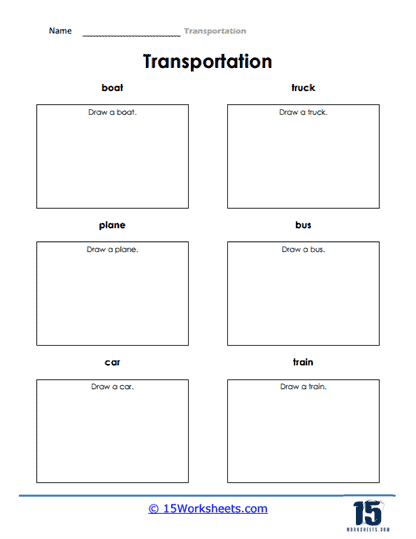Transportation Worksheets
All About These 15 Worksheets
This carefully curated collection of 15 worksheets is more than just a set of exercises; it is an interactive journey designed to captivate students and deepen their understanding of one of the most essential aspects of our modern world-transportation. Through thoughtfully crafted activities and hands-on learning experiences, students will not only become familiar with various modes of transportation, but also begin to appreciate their significance in our daily lives and on a global scale.
Transportation is all around us. Whether it’s the car you ride in to school, the bus that takes people to work, the airplane that soars across the skies, or the boat that sails on distant waters, these modes of transportation connect people, cities, and even countries. They help move goods, support economies, and create the possibility for people to explore different parts of the world. With this collection of worksheets, students are invited to embark on an educational exploration that broadens their perspective on how transportation plays a crucial role in our interconnected society.
Through engaging exercises, students will explore the names and characteristics of various forms of transportation, including cars, buses, trains, planes, and boats. By interacting with colorful illustrations and real-world examples, they will not only recognize these vehicles but also begin to classify them according to their environment-land, air, or water. This process of classification encourages critical thinking, as students must analyze the different ways these modes of transportation operate and where they are best suited. It’s not just about identifying a car or a plane; it’s about understanding how they contribute to the broader system of human movement and commerce.
One of the key benefits of this collection is that it encourages students to distinguish between everyday objects and modes of transportation. While a bicycle or a skateboard might be familiar objects to them, thinking about how these items function as transportation tools sharpens their analytical skills. By asking questions like, “What makes a bus different from a car?” or “How does a boat move on water?” students begin to engage with the concept of purpose and function. These worksheets go beyond rote memorization, prompting students to actively consider why different modes of transportation exist and how they serve the needs of people across the world.
Language development is another crucial aspect of this collection. By working through sentence-building exercises, students will not only learn to correctly identify the names of vehicles but also discover the appropriate verbs and language structures that accompany discussions about transportation. For example, students will learn when to use terms like “fly,” “sail,” “drive,” and “ride” in sentences, helping them improve both their vocabulary and sentence construction. This linguistic component reinforces their understanding of transportation in practical ways, making it easier for them to communicate these ideas clearly and confidently.
Creativity is also at the heart of these worksheets. Students will have the opportunity to express their imaginative side by drawing pictures of various modes of transportation. Whether they are sketching a futuristic train that runs on solar energy or a whimsical boat that travels under the sea, these creative exercises allow them to think beyond what already exists. By visualizing transportation in new and exciting ways, students can develop a deeper interest in the subject while also nurturing their artistic skills.
As students progress through the worksheets, they will not only gain a comprehensive knowledge of transportation but also begin to think critically about its role in the future. Transportation is an ever-evolving field, with advances in technology constantly reshaping the way people and goods move from place to place. Electric cars, autonomous vehicles, high-speed trains, and even space travel are all emerging innovations that are set to transform our world. By learning about the current modes of transportation, students can start to envision what the future might look like-perhaps even inspiring some of them to become the innovators and engineers who shape the transportation systems of tomorrow.
What Are The Modern Forms of Transportation?
Transportation has undergone a remarkable transformation throughout human history. From the days when people walked long distances on foot, traversing difficult terrains and facing nature’s obstacles, to the invention of futuristic hoverboards, transportation has consistently been an area of relentless innovation. At the heart of this transformation lies human ingenuity, continuously pushing the boundaries of what is possible. Thanks to advancements in technology, transportation today is more accessible, affordable, and safer than ever before.
In our modern world, transportation is no longer a one-size-fits-all concept. There are now numerous options available to suit individual preferences, needs, and circumstances. Whether you are considering your budget, the distance you need to travel, or the level of comfort you desire, you have the freedom to choose from a wide array of transportation modes. Understanding these options allows us to travel with ease, navigate unfamiliar routes without confusion, and even reduce our environmental footprint through smarter transportation choices.
Let’s explore some of the most common forms of transportation that have become essential parts of our daily lives:
Cars
Cars are arguably the most familiar and widely used form of transportation in today’s world. A car, with its four wheels and motor engine, is designed to transport people and goods on roads efficiently. The flexibility that comes with owning or using a car is unparalleled—drivers can go wherever and whenever they please without relying on public schedules. Over the years, technological advancements in car manufacturing have improved fuel efficiency, reduced emissions, and enhanced safety, making cars a more eco-friendly and dependable choice. Electric cars, in particular, have risen in popularity, presenting a solution to reduce carbon emissions and reliance on fossil fuels.
Buses
Buses serve as a lifeline in public transportation networks, particularly in urban areas. These large motor vehicles are designed to carry a significant number of passengers, often operating on regular routes with multiple stops along the way. Buses offer an affordable and environmentally friendly alternative to driving personal cars, reducing traffic congestion and cutting down on pollution. Whether for a daily commute or long-distance travel, buses make transportation accessible to people of all socioeconomic backgrounds, making cities more interconnected.
Trains
Trains remain one of the most efficient and reliable forms of transportation, especially for long distances. Operating on a series of connected railway carriages or wagons, trains transport passengers and goods on rails. In many countries, trains serve as the backbone of national transportation systems, offering high-speed alternatives for intercity travel. Innovations like bullet trains and magnetic levitation trains (maglev) demonstrate just how far the rail industry has come in improving speed, comfort, and efficiency. Train travel reduces road congestion and has a lower environmental impact than air travel or driving, making it an attractive option for eco-conscious travelers.
Motorcycles
Motorcycles, with their two wheels and powerful engines, offer a fast and nimble option for those looking to travel short or moderate distances. Designed for one or two riders, motorcycles provide a sense of freedom that few other vehicles can match. The ability to maneuver through traffic and navigate narrow streets makes motorcycles especially popular in densely populated urban environments. For many, motorcycles are not just a means of transportation-they represent a lifestyle centered around adventure and excitement. However, safety is a key consideration, as motorcycles require greater skill and attention from riders due to their high speeds and exposure to road hazards.
Bicycles
Bicycles are a simple yet effective mode of transportation that has stood the test of time. As a pedal-powered vehicle with two wheels, the bicycle offers a cost-effective, environmentally friendly, and health-conscious option for getting around. Whether used for commuting, exercise, or leisurely rides, bicycles have experienced a resurgence in recent years due to the growing emphasis on sustainability and reducing one’s carbon footprint. Many cities have adapted by creating bike lanes, offering bike-sharing programs, and promoting cycling as a practical alternative to driving. Riding a bicycle not only reduces pollution but also promotes physical well-being.
Boats
When it comes to water transportation, boats are a versatile option. These watercraft are designed to carry people or goods across bodies of water, propelled by oars, sails, or engines. From small recreational boats that sail on lakes to commercial fishing boats that venture into the deep sea, boats remain an essential mode of transport for those living near water. The use of boats dates back to ancient civilizations, and while their design has evolved, their fundamental purpose remains the same: to move people and goods across water efficiently.
Ships and Ferries
For larger-scale water transportation, ships and ferries play a vital role. Ships, larger and more robust than boats, are used for long-distance travel and the transportation of large quantities of cargo. They are essential for global trade, as ships transport the majority of goods across oceans. Ferries, on the other hand, are designed to transport passengers and vehicles over shorter distances, usually between islands or across rivers. Regular ferry services make it possible for people to live in areas separated by water while still having access to essential services and work opportunities on the mainland.
Airplanes
Air travel revolutionized the way people think about distance and time. Airplanes, with their fixed wings and powerful engines, enable people to travel vast distances in a fraction of the time it would take using other modes of transportation. Whether for domestic or international travel, airplanes have become a necessity for business, tourism, and global trade. The aviation industry continues to innovate with advancements in aircraft design, fuel efficiency, and reducing emissions, aiming for a future where air travel is not only faster but more sustainable.
Helicopters
Unlike airplanes, helicopters offer a unique form of air travel that can lift off vertically and fly in any direction. This versatility makes helicopters ideal for emergency services, rescue operations, and military purposes, as well as for transporting people to remote or otherwise inaccessible locations. Helicopters are also used in metropolitan areas for fast, direct travel, providing services such as air taxis or traffic monitoring. While not as common as airplanes, helicopters fill an important niche in transportation where speed and flexibility are critical.
Subways
In densely populated urban areas, subways are an essential part of the public transportation system. Operating underground, subways provide a fast, reliable, and affordable way for people to navigate cities without adding to surface-level congestion. Subways are particularly effective in reducing traffic in large metropolitan areas, offering commuters a way to avoid the gridlock often found in city streets. The extensive network of subway systems in cities like New York, London, and Tokyo exemplifies how subways have become indispensable in modern urban life.
Scooters and Taxis
For short-distance travel, scooters and taxis provide convenient options. Scooters, often powered by small engines or electric motors, are ideal for quick, efficient trips in busy urban environments. They are a popular choice for individuals looking for an easy, eco-friendly way to get around. Taxis, on the other hand, offer a more personalized travel experience. Available for hire on-demand, taxis allow passengers to travel directly to their destination without the need for schedules or stops. Both scooters and taxis provide flexibility for travelers who need to get from one place to another without owning a vehicle.
Each of these modern forms of transportation plays a unique role in our daily lives, shaping how we move through the world. By understanding the options available, we can make informed choices that suit our needs, whether we’re commuting to work, traveling across continents, or simply enjoying a weekend ride.

